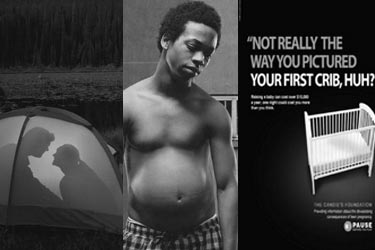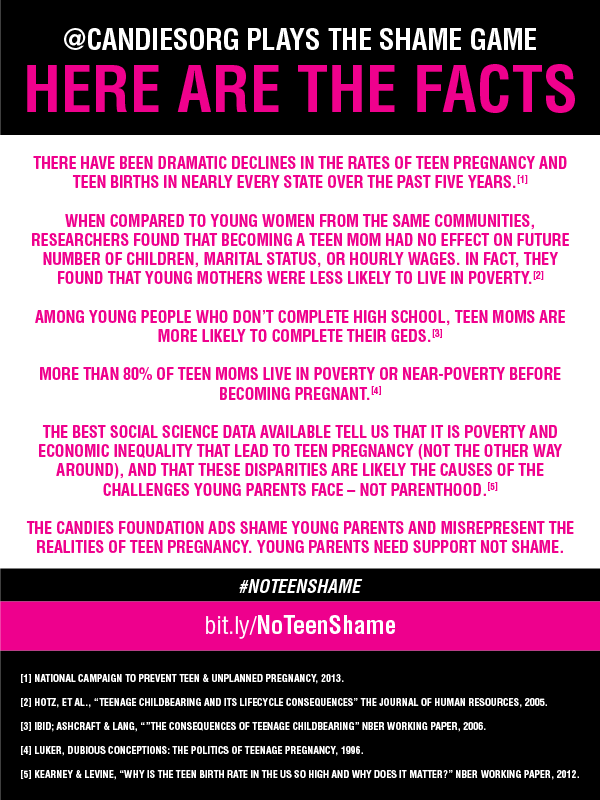What Would a Decent Teen Pregnancy Prevention Campaign Look Like?
Sadly, most teen pregnancy campaigns aren't focused on teen pregnancy prevention; they're teen parenting prevention campaigns.

It feels like every time I turn around, there’s another offensive teen pregnancy or parenting ad campaign. The Candie’s Foundation, which was created by Neil Cole of the apparel company Candie’s that is popular with young girls, joined the fray with its own offensive ad campaign for Teen Pregnancy Prevention Month in May.

Veronica Bayetti Flores at Feministing.com broke that one down nicely. Then an ad campaign was released by the Chicago Department of Public Health featuring alarmist photos of teenage boys with photoshopped baby bumps, like this one:

While campaigns like the one launched by the Candie’s Foundation have celebrity endorsements that propel them, I’m always more disgusted to see campaigns like Chicago’s, or the one in New York City earlier this year, where public funding has been used to make them happen—public dollars that could be used in many other ways that actually might have an impact on the lives of teenagers and parents of all ages. The Chicago campaign also has the strange side effect of being transphobic, accidentally depicting what could be a pregnant transgender man.
All of these campaigns have left me to wonder if there is a teen pregnancy prevention campaign I would support. Sadly, the crux of most of these campaigns, and especially the Candie’s Foundation and New York City campaigns, isn’t actually teen pregnancy prevention—they are teen parenting prevention campaigns, which I could never get behind. I would never support an initiative that shames and defames teen parents and spreads statistics that are taken out of context and claim teen parents, especially teen mothers, will never succeed.
This response to the Candie’s Foundation campaign illustrates how statistics commonly used to defend teen parenting prevention campaigns can be distorted:

The only kind of prevention campaign I would support is an unwanted pregnancy prevention campaign. Because that is the only kind of pregnancy I think we should be trying to prevent. We shouldn’t try and prevent people we think are too young, too old, or too irresponsible from conceiving. Every person has the right to parent when they see fit. Instead, we should be trying to get the correct tools and information into the hands of people who don’t want to become pregnant, but who might not know how to prevent it. And the way to execute this kind of campaign isn’t to discourage teens from pregnancy by telling them how horrible life will be once they have a child, but by telling them how not to get pregnant.
Among the many terrible things they promote, like stigma and shame for an already stigmatized group, these campaigns also seem to support the idea that teens get pregnant because they don’t know how hard it will be to be a teen parent. I think that’s absurd.
A recent campaign in Colorado comes close to being an acceptable unwanted/unintended pregnancy prevention campaign. Instead of using alarmist photos or statistics about the fate of teen parents, it presents humanizing and respectful images of young couples. Take this one:

While it isn’t perfect, it does succeed in avoiding the shame and paternalizing tone that the other campaigns have. Even the description of the campaign displays this difference in language and tone: “The Colorado Department of Health and Environment has recently launched a campaign and website to reduce unintended pregnancy, STD rates, and raise awareness on sexual health.”
Even its section on pregnancy, while providing information about the challenges of parenting, lacks much of the discouraging and stigmatizing tone found in other campaigns. The site’s answers to questions like “How will having a baby affect the rest of my life?” describe the challenges, but also leave open the possibility of young people choosing this path. It also doesn’t make sensationalist statements about what being a parent will mean for their future, like other campaigns that imply the children of teen moms will never succeed.
Consider what it will feel like to place some of your own dreams on hold or experience them differently. Finishing college, settling into a new home or starting a new job or business will be a lot more difficult with a baby in tow. These are all crucial considerations that you should think about and discuss with your partner, friends, family and health care provider before becoming pregnant. Your whole life will change, so being ready is key.
While it’s heartening to find examples of awareness and education campaigns that don’t smack of stigma and disrespect for teens and teen parents, all of these initiatives still raise the question: Are they worth it? Is this how our public health dollars should be spent? With the Centers for Disease Control and Prevention recently reporting a continued steep decline in teen pregnancy rates, I’m not so sure.
Teen birth rates fell steeply in the United States from 2007 through 2011, resuming a decline that began in 1991 but was briefly interrupted in 2006 and 2007. The overall rate declined 25% from 41.5 per 1,000 teenagers aged 15–19 in 2007 to 31.3 in 2011—a record low. The number of births to teenagers aged 15–19 also fell from 2007 to 2011, by 26% to 329,797 in 2011.
These ad campaigns may have one positive side effect, though, which is galvanizing activist support for teen parents and against these shame and stigma campaigns. I’ve been heartened by the response to the Candie’s Foundation and the New York City ads, and I just hope that the teen parents out there also are seeing these messages of support.
When it comes to public health dollars, I’ve got a lot of ideas on how they should be spent, and flashy ad campaigns that cost $400,000 to serve up discriminatory messages to young people isn’t one of them.
